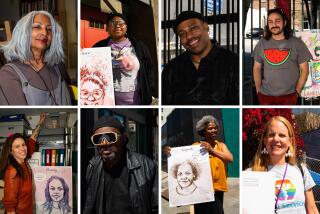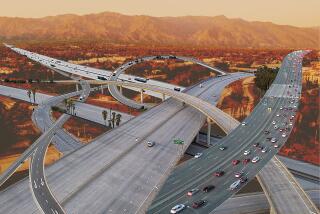‘Superclogger’: Puppet shows for the congested freeways of L.A.
The freeway appears regularly in L.A. art — works by Ed Ruscha, Dennis Hopper and Catherine Opie come to mind — but rarely does art grace the Southland’s concrete corridors. There is graffiti, of course, and a smattering of decaying murals, but for the most part, the freeway is an artistic wasteland.
Until now. Coming to select rush hour traffic jams this summer: “Superclogger,” a mobile puppet theater by Los Angeles artist Joel Kyack. Accompanied by fellow artist Michael Hayden, Kyack performs shows out of the back of his nondescript white pickup truck for anyone who happens to be driving behind it.
Commissioned by the Culver City non-profit LAXART, “Superclogger” began its crawl through the Southland’s most congested stretches of freeway on June 1, on the 405. (Kyack monitors the flow of traffic on Google Maps to find the slowest spots.) Additional shows will appear sporadically through Sept. 25, when they will be featured in an event at the Hammer Museum. Upcoming dates and freeways are listed on the LAXART website (www.laxart.org).
“Los Angeles has such a long history of cars and car culture that it almost seemed like a perfect project to see how a young, emerging artist would respond to this context,” says Cesar Garcia, curator of public art and programs at LAXART.
Starting roughly at 5 p.m. on designated days, lucky commuters will see the back of the pickup’s shell top swing open to reveal an energetic hand puppet dressed like a heavy metal musician. If they tune their radios to the frequency written on a cardboard sign on the tailgate, they’ll hear crashing guitar chords and a gravelly announcer’s voice say, “Welcome to ‘Superclogger’!”
What follows are four vignettes, each between 4 and 7 minutes long, in which characters discuss the vicissitudes of fame, friendship, snobbery, artistic integrity and love. An aging country singer laments the price of success; a naive young boy confronts upper class pretensions in a surreal conversation with a talking shrub; two construction workers shed their tough guy image with a karaoke version of Joni Mitchell’s “Both Sides Now”; and an isolated writer sets aside his novel for a lucrative screenplay and love.
All the scenes are about “characters sort of negotiating their want or their desire to make a world around them,” Kyack says, “and then the will of the world often times putting up those blocks.”
Kyack doesn’t mind if people don’t get the connection between the stories and gridlock; he doesn’t even expect them to watch the entire show. “If someone saw 30 seconds of one of the plays, I think it’s just as good,” he says. For him, the content is secondary to the show’s potential to transform the space around it. The plays are “kind of a trick, or that point of entry for someone to come in and then experience this performative space,” he says.
Kyack hopes the novel experience of seeing a puppet show while idling in traffic will jolt commuters out of isolation in their cars and help them see other possibilities in their surroundings. For one thing, drivers might be more aware of the potential for a fender bender and exercise caution while watching the puppet show. But there are also larger questions about what behaviors are acceptable or permitted within a given space.
“How much have you forfeited?” he asks, in his typically emphatic, animated manner. “How much have you resigned? How much space? The highway is a complete forfeiture to the government. To their rules, to their land grab.”
Case in point: Driving east on the 210 on a recent Wednesday afternoon, Kyack and Hayden quickly push the puppets out of sight as they pass a Highway Patrol car on the side of the road. “We’re not doing anything illegal,” Kyack says. “The truck is modified with seatbelts. I’m completely in compliance with the FCC.” Since the transmitter radius is only about 100 feet and it broadcasts on unused frequencies in the area where the truck is driving, Kyack says the project does not require a license from the Federal Communications Commission.
California Highway Patrol spokesman Mark Garrett was not aware of any incident reports regarding the project. “There’s no specific law that prohibits someone from doing something like that as long as they’re seated legally,” Garrett said.
For all its careful planning, the project has a decidedly handmade, impromptu vibe.
“I’m not a puppet maker. I’m not a playwright. This is the first time I’ve done either one,” says Kyack. He wrote the scenarios, made all the puppets by hand and recorded the music, sound effects and voices (his and Hayden’s) over a period of about eight months. Pre-recorded on CD, the soundtrack is broadcast from a small FM transmitter in the truck. The two men dress in black with cheap black pantyhose over their faces and sit in seats installed by a friend of Kyack’s, master welder Peter Fuller. There is no curtain; the puppeteers’ forms, if not their faces, are discernible behind the puppets.
“Materially, both for the modifications to the pickup truck and the puppets, I’d say it was just under $300,” says Kyack. This low-budget approach is integral to the project and his work in general, which also includes sculpture, installation and non-puppet performances.
“Legitimacy is so often informed by the financial backing,” he says, “I like to think I’m operating in opposition to that, where I’m showing people that ideas can happen very simply too.”
More to Read
The biggest entertainment stories
Get our big stories about Hollywood, film, television, music, arts, culture and more right in your inbox as soon as they publish.
You may occasionally receive promotional content from the Los Angeles Times.










